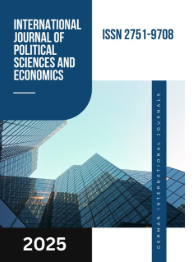CHRONIC INFLAMMATION: PATHOGENESIS, CAUSES, AND TREATMENT METHODS
DOI:
https://doi.org/10.55640/Keywords:
Inflammatory biomarkers, C-reactive protein (CRP), Interleukin-6 (IL-6), Tumor necrosis factor-alpha (TNF-α), Erythrocyte sedimentation rate (ESR), Metabolic syndrome, Autoimmune disorders, Systemic inflammation, Biomarker evaluation.Abstract
The research examines clinical along laboratory features of chronic inflammation through data collected from the Multidisciplinary Clinic of Samarkand State Medical University dating from 2022 to 2024. Multiple diseases develop from chronic inflammation yet medical experts still lack understanding about its diagnostic patterns and biomarker profiles when observed in natural clinical environments. The research examined 210 patients above 18 years who sought care for ongoing inflammatory disorders. Study results analyzed the biomarkers C-reactive protein (CRP) and erythrocyte sedimentation rate (ESR) and interleukin-6 (IL-6) together with tumor necrosis factor-alpha (TNF-α) and demographic characteristics and comorbidities and therapeutic outcomes. Medical staff excluded patients from the study who had acute infections and missing clinical documentation. The statistical evaluation was done using SPSS version 26.0. The research showed that patients displayed elevated inflammatory markers yet significant differences appeared when comparing between disease groups and patient ages. The most common causes of chronic inflammation stemmed from metabolic and autoimmune disorders yet these patients continued to experience unfavourable clinical results even when under medical treatment. The research results demonstrate the necessity of developing better approaches for identifying inflammatory markers at an earlier stage combined with patient-specific medical care. This study demonstrates why monitoring biomarkers routinely remains crucial for both diagnosis and management in tertiary medical care settings that face chronic inflammation as a key clinical issue. The research produces local insights about Uzbekistan which could serve as guidance for future medical strategies and health policy development.
References
1.Medzhitov R. (2008). Origin and physiological roles of inflammation. Nature, 454(7203):428–435.
2.Hotamisligil GS. (2006). Inflammation and metabolic disorders. Nature, 444(7121):860–867.
3.Libby P, Ridker PM, Hansson GK. (2011). Inflammation in atherosclerosis. J Am Coll Cardiol, 58(7):712–721.
4.Heneka MT, et al. (2015). Neuroinflammation in Alzheimer’s disease. Lancet Neurol, 14(4):388–405.
5.Ridker PM. (2003). Clinical application of C-reactive protein for cardiovascular disease detection and prevention. Circulation, 107(3):363–369.
6.Feldmann M, Maini RN. (2001). Anti-TNF alpha therapy of rheumatoid arthritis: what have we learned? Annu Rev Immunol, 19:163–196.
7.Taniguchi K., & Karin M. (2018). NF-κB, inflammation, immunity and cancer: coming of age. Nature Reviews Immunology, 18(5), 309–324.
8.Gisterå A., & Hansson G. K. (2017). The immunology of atherosclerosis. Nature Reviews Nephrology, 13(6), 368–380.
9.Singh T., & Newman A. B. (2011). Inflammatory markers in population studies of aging. Ageing Research Reviews, 10(3), 319–329.
10.Franceschi C., & Campisi J. (2014). Chronic inflammation (inflammaging) and its potential contribution to age-associated diseases. Journals of Gerontology Series A: Biomedical Sciences and Medical Sciences, 69(Suppl_1), S4–S9.
11.Саидова Ф. С., Самиева Г. У., Абдирашидова Г. А. Дефицит микронутриентов у детей дошкольного возраста //Журнал биомедицины и практики. – 2022. – Т. 7. – №. 1.
12.Pradhan A. D., Manson J. E., Rifai N., Buring J. E., & Ridker P. M. (2001). C-reactive protein, interleukin 6, and risk of developing type 2 diabetes mellitus. JAMA, 286(3), 327–334.
13.Саидова Ф. С. и др. Юрак-Қон Томир Касалликларининг Стрессга Боғлиқ Патофизиологик Механизмлари //Miasto Przyszłości. – 2024. – Т. 50. – С. 74-77.
Downloads
Published
Issue
Section
License

This work is licensed under a Creative Commons Attribution 4.0 International License.
Authors retain the copyright of their manuscripts, and all Open Access articles are disseminated under the terms of the Creative Commons Attribution License 4.0 (CC-BY), which licenses unrestricted use, distribution, and reproduction in any medium, provided that the original work is appropriately cited. The use of general descriptive names, trade names, trademarks, and so forth in this publication, even if not specifically identified, does not imply that these names are not protected by the relevant laws and regulations.







